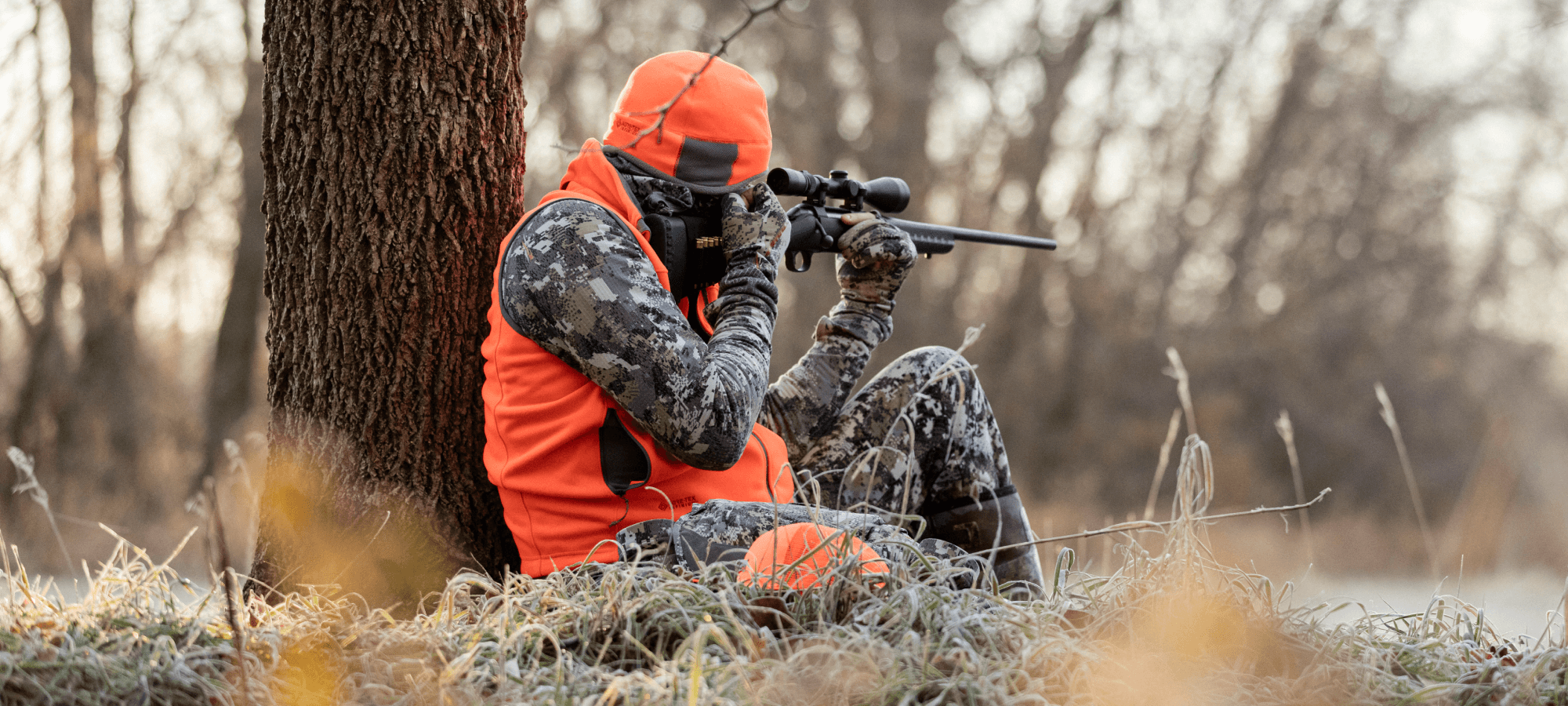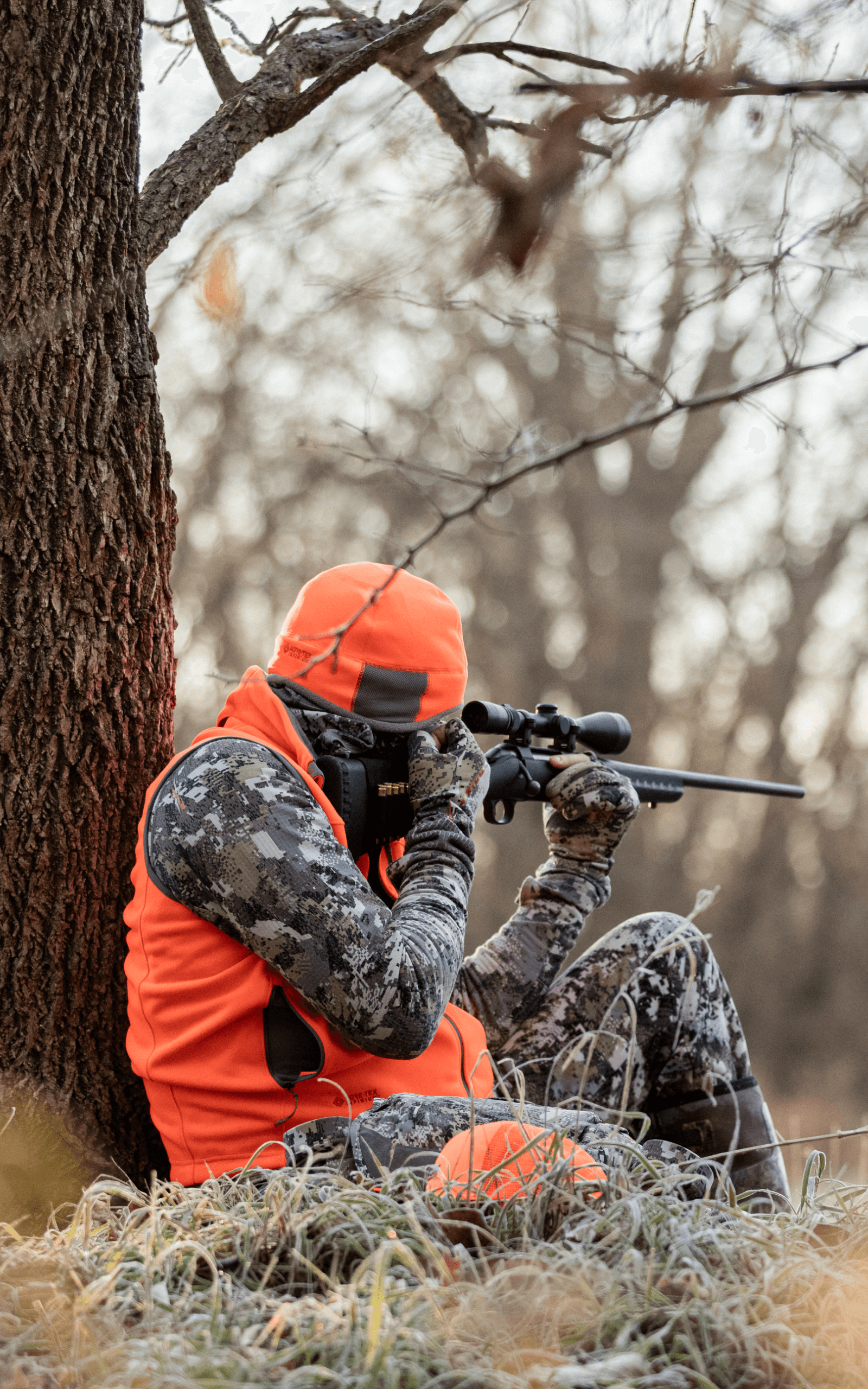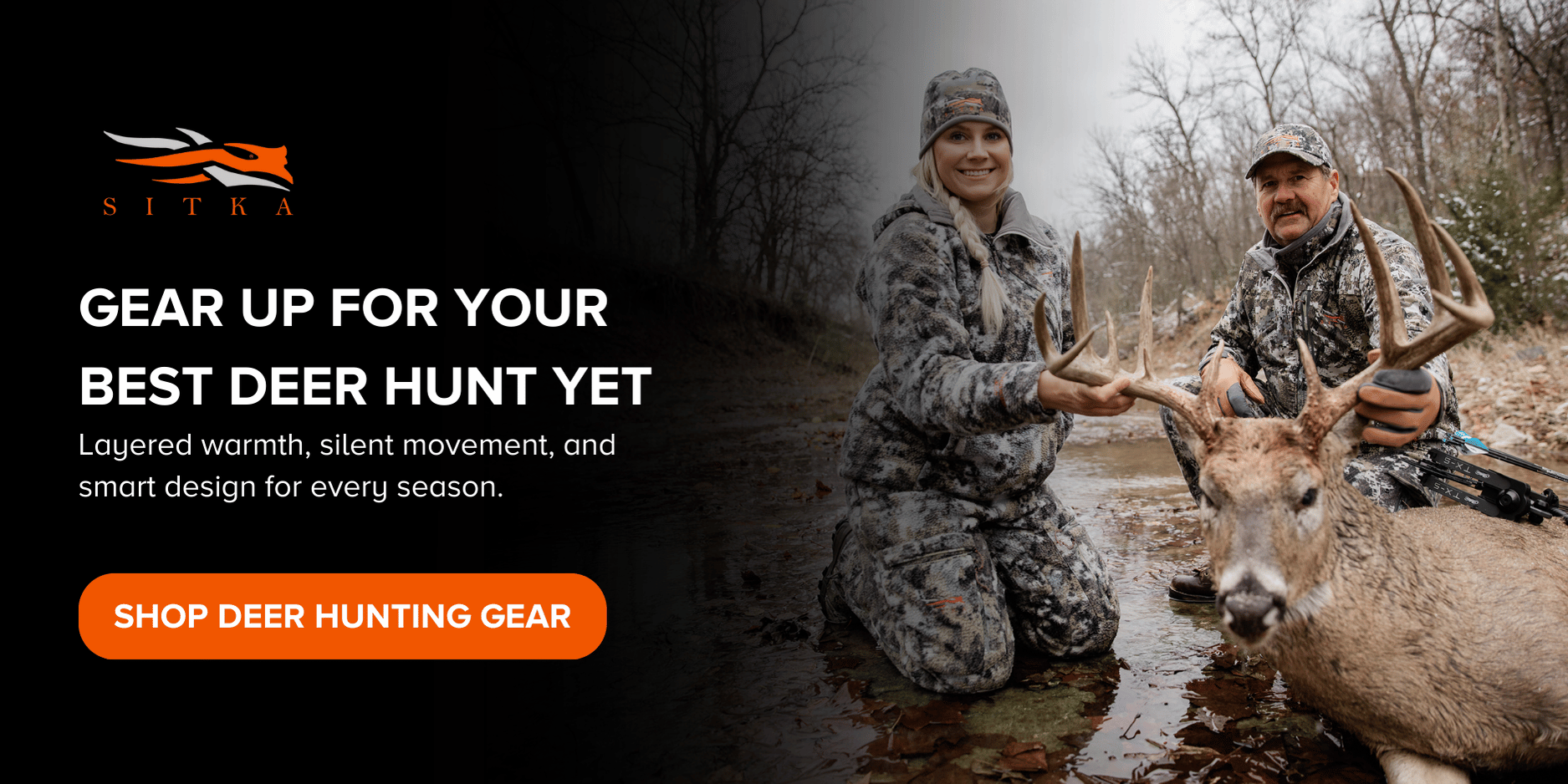Joe Fields | 6.23.2025
Where to Shoot a Deer with a Bow or Rifle
Knowing where to shoot a deer with a bow or rifle is an integral part of deer hunting. Proper shot placement matters for ethical bowhunting and gun hunting. It’s a personal responsibility every hunter must learn, master, and employ when hunting deer, whether that be whitetails or mule deer. Failing to do so is to disrespect our natural resources.
It’s so important to learn that people spend much of their hunter education course studying it. After all, the last thing we want is a wounded deer. Rather, we aspire for a firm understanding of deer anatomy.
As with other elements of deer hunting, knowing where to shoot a deer is multifaceted. Hunters must grasp numerous elements before heading afield. Once time to hunt, it’s crucial to know the ins and outs of shot placement on whitetail deer. Hunting regulations guide many of a hunter’s actions, but ethics aid hunters in the matter of shot placement. Here’s what to know on where to shoot a deer.
Understanding Deer Anatomy
Deer have a complex anatomical system. Deer hunters should learn how to kill deer quickly and humanely. Hitting the vital organs is crucial for a quick harvest, and anyone serious about hunting deer must be serious about getting this part of it right.
Vital Organs for Ethical Shots
It’s important to understand the anatomy of a deer and focus on the heart and lungs as the primary targets for ethical shots. Of course, other organs are vital for survival, including liver, intestines, and more. That said, these are not ethical shot placements, and can take hours or even days before death. Because of this, it’s vital to focus on the two organs that are ethical shot placements, which include the heart and lungs.
The "Boiler Room” Explained
The area that encompasses the top of the heart and the lungs is referred to as the "boiler room." This area is significant in that it ensures a quick, clean, ethical kill. A well-placed bullet or broadhead that strikes this region is generally lethal within seconds.
Unethical Shot Placements
Certain shot placements are not ethical. Neither bow nor gun hunters should take head shots. Bowhunters should never purposely aim for other areas that are vitals (but that take too long before being lethal), such as arteries, liver, paunch, intestines, etc. Bowhunters should also never take neck shots, among others.
While certain unethical shot placements should never be purposely taken, new hunters must understand that accidents happen. Eventually, if a hunter hunts long enough, they’ll make a poor shot, even under the best circumstances and intentions.
When this occurs, give deer ample time to expire before blood trailing. Or, if possible, follow up immediately with a second shot.
Sometimes, hunting regulations permitting, it might require a deer tracking dog. Other times, it might require several people grid-searching an area. Regardless, do everything in your power to recover wounded game. How you react to a negative situation determines how ethical you are as a deer hunter.
Shot Placement for Different Scenarios
As taught in hunter ed, the best shot opportunity is a broadside deer. Of course, hunters aren’t always presented with the perfect shot opportunity, but that doesn’t mean others aren’t ideal or ethical. Certainly, deer can provide a variety of shot angles that are considered lethal and ethical opportunities for deer hunters. A hunter wants to strike the heart and/or both lungs (i.e.: a double-lung hit) for the fastest succumbing to the shot. That can be achieved in a variety of ways and opportunity types.
Broadside Shots
A broadside shot opportunity is the ideal situation. With a broadside deer, the best aiming point for a deer standing broadside, is right behind the crease of the front leg. That said, bowhunters and rifle hunters often use slightly different aiming points. Weapon type influences the process. Heed the following tips for archery and gun hunters.
Bowhunters should focus on the crease just behind the front leg. With a deer’s legs perpendicular to the ground, imagine a line running up the back of the front leg. Aim along that line approximately ¼ to 1/3 up the animal’s torso. This will cause the arrow to strike the heart and lung region of the deer.
Firearm hunters can use the same aiming point. That’s perfectly acceptable. However, some gun hunters choose to aim slightly more forward, and slightly higher, on the deer’s heart and lung region. Sometimes, this can produce more “shock” effect, and might cause the deer to travel a shorter distance, or even drop in its tracks.
Quartering-Away and Quartering-To Shots
Hunters should also be able to adjust aiming points when deer are quartering away or toward the deer hunter. Hunters must compensate for the angle to hit the vital organs.
Imagine the deer from a bird’s eye view. If the deer is broadside, the lungs overlap one another completely. However, when that deer turns left or right (i.e.: a quartering-to or quartering-away shot opportunity) and is no longer broadside (perpendicular to the hunter), the lungs no longer overlap one another perfectly.
Because of this, if the hunter aims the same as if they would at a broadside deer, it can lead to the broadhead or bullet striking only one lung, rather than two. A single-lung hit can be lethal but isn’t always. Even when it is, it can be a long-suffering death, which no hunter wants, so a single lung shot is not ideal.
To prevent a single lung shot placement, it’s important to consider shot angles. When a hunter aims correctly, quartering-to and quartering-away shot opportunities are still completely ethical.
Quartering-away and quartering-to shot opportunities do not impact aiming elevation (how high or low to aim), but it does impact windage (how far left or right to aim). If a deer is quartering slightly toward the hunter, a hunter should move the aiming point forward slightly. The more it’s quartering, the greater the adjustment. If a deer is quartering slightly away from the hunter, a hunter should move the aiming point backward slightly. Again, the more it’s quartering, the greater the change.
To best decide how to aim at a quartering deer, draw an imaginary straight line that starts at the aiming point, travels through the deer, and exits on the other side. If it passes through the heart and/or both lungs, that’s great. If not, adjust your aiming point as needed.
Note that when a deer is quartering toward the hunter, there is significantly less margin for error in terms of shot placement, making it debatable whether this is an ethical shot. You must be confident in your abilities to hit your mark when deciding whether or not to take this shot.
Elevated Shots
Elevation is another relevant factor. In fact, shot placement and aiming points change when hunting from elevated positions, including elevated hunting blinds and treestands. It’s also relevant for those who hunt in steep and varying terrain.
While a deer that’s on the same plane (elevation) as the hunter, a change in up-and-down aiming point is not necessary. That said, when a hunter is higher or lower than the deer, it’s crucial to adjust the aiming point.
The most common scenario involves the hunter being higher than the deer. When this occurs, hunters should aim slightly higher. This ensures a double-lung hit, rather than the single-lung result. Aiming too low risks striking only the near-side lung.
If the deer is at a higher position than the hunter, move the aiming point slightly lower to get the desired shot placement. Aiming too high can also result in striking only the near side lung.
Special Considerations
Certain hunting situations might require special shot placement considerations. This applies to understanding shot angles, the challenges of moving targets, and more.
Understanding Shot Angles
Deer hunters should know different angles affect the path of a bullet or arrow through a deer's body. Furthermore, they should understand how to visualize the shot. Mastering each of these skills is required for maximum effectiveness.
In addition to understanding how elevation (up and down) and windage (left and right) impact aiming points, other things are involved with shot angles, too.
For example, consider other deer around the target animal. Is there a deer in front of it? Is there a deer behind it? If so, and another deer is in the arrow or bullet’s line of travel (before or after striking the target), don’t shoot. Also consider what else is behind your target. If there are campsites, hikers, houses or unknown territory behind your target, do not shoot.
The Challenge of Moving Targets
There are significant difficulties involved with shooting at moving deer. Therefore, learning certain strategies can increase the odds of successful shot placement.
Bowhunters should never take a shot at a moving deer. Hunters should wait for the deer to stop walking before taking a shot. Even for the best archers, arrow speeds are not high enough for accuracy on a moving target.
On the other hand, in this regard, gun hunters use faster projectiles, and therefore, enjoy more ethical freedom. While it’s important to not stretch this liberty too far, firearm carriers can take ethical shots at deer moving at slow rates of speed. Of course, the distance to target, target rate of speed, wind speed, and more, can impact how far forward the shooter should hold. Most hunters should wait for the animal to naturally pause or should attempt to stop the animal from moving before taking a shot.
Equipment and Practice
Equipment also plays a role in shot placement. As mentioned, the speed of your projectile (measured in feet per second), makes shots easier or more difficult for shooters. Of course, hunters must practice with their weapon of choice to understand how much they should alter their hold (aiming point) under different circumstances.
Choosing the Right Gear
Begin by selecting the best gear for the job. Find a bow or firearm, and arrow and broadhead setup or ammunition, that best fits your situation. You must feel comfortable with the weapon to be effective with it. This is an important step in becoming an ethical hunter.
The Importance of Practice
Additionally, regular practice is required to improve shooting accuracy. This also boosts confidence in shot placement. Practicing both typical and difficult hunting scenarios elevates personal skill level. Spend ample time (weekly) honing the craft. It’s important to know the distance you are confidently accurate and to not take shots over that distance even when they’re tempting. It’s a good idea to have a distance in mind before going out and sticking with it, rather than trying to decide whether or not to take a shot during a heated moment in the field.
SITKA Gear's Commitment to Ethical Hunting
It’s obvious that hunters (https://www.sitkagear.com) must understand deer anatomy, proper aiming points, shot placement scenarios, and more, to be an ethical hunter. Failing to check these key boxes can lead to unethical harvest decisions. Understanding these key factors increases the chances of a quick, humane harvest.
Of course, SITKA Gear's hunting apparel (https://www.sitkagear.com/mens/all), and its gear designs, are crafted to support hunters in achieving accurate and ethical shots. For example, quality hunting clothing that keeps a hunter dry and warm is more apt to be comfortable, relaxed, and ready to make a good shot. Secondly, quiet clothing helps hunters move, draw their bow, or shoulder their gun, without alerting deer. A calm, relaxed deer is an easier target than an alert one.
Because of this, hunters in the market for quality hunting clothing and gear should explore SITKA Gear's range of hunting apparel. After all, the brand is committed to innovation, utmost performance, and without question — the ethical pursuit of small and big game (https://www.sitkagear.com/pursuit/whitetail).


